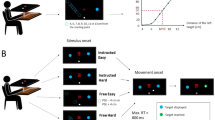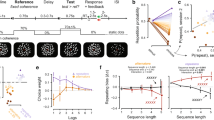Abstract
The neural pathways for generating willed actions have been increasingly investigated since the famous pioneering work by Benjamin Libet on the nature of free will. To better understand what differentiates the brain states underlying willed and forced behaviours, we performed a study of chosen and forced actions over a binary choice scenario. Magnetoencephalography recordings were obtained from six subjects during a simple task in which the subject presses a button with the left or right finger in response to a cue that either (1) specifies the finger with which the button should be pressed or (2) instructs the subject to press a button with a finger of their own choosing. Three independent analyses were performed to investigate the dynamical patterns of neural activity supporting willed and forced behaviours during the preparatory period preceding a button press. Each analysis offered similar findings in the temporal and spatial domains and in particular, a high accuracy in the classification of single trials was obtained around 200 ms after cue presentation with an overall average of 82%. During this period, the majority of the discriminatory power comes from differential neural processes observed bilaterally in the parietal lobes, as well as some differences in occipital and temporal lobes, suggesting a contribution of these regions to willed and forced behaviours.






Similar content being viewed by others
References
Baars BJ, Ramsoy TZ, Laureys S (2003) Brain, conscious experience and the observing self. Trends Neurosci 26:671–675
Blankertz B, Dornhege G, Lemm S, Krauledat M, Curio G, Müller KR (2006a) The Berlin Brain-Computer Interface: machine learning based detection of user specific brain states. J Universal Comput Sci 12:581–607
Blankertz B, Krauledat M, Losch F, Curio G, Müller KR (2006b) Combined optimization of spatial and temporal filters for improving brain-computer interfacing. IEEE Trans Biomed Eng 53:2274–2281
Blankertz B, Kawanabe M, Tomioka R, Hohlefeld F, Nikulin V, Müller KR (2008) Invariant common spatial patterns: alleviating nonstationarities in brain-computer interfacing. Adv Neural Inform Process Syst 20:113–120
Damasio A (1999) The feeling of what happens: body and emotion in the making of consciousness. Harcourt Brace, New York
Desmurget M, Sirigu A (2009) A parietal-premotor network for movement intention and motor awareness. Trends Cogn Sci 13:411–419
Dornhege G, Blankertz B, Krauledat M, Losch F, Curio G, Muller KR (2006) Optimizing spatiotemporal filters for improving brain-computer interfacing. In: Advances in Neural Info Proc Systems (NIPS 05), vol 18. MIT Press, Cambridge, MA, pp 315–322
Frith CD, Friston K, Liddle PF, Frackowiak RS (1991) Willed action and the prefrontal cortex in man: a study with PET. Proc R Soc Lond B 244:241–246
Golland P, Fischl B (2002) Permutation tests for classification: towards statistical significance in image-based studies. Inf Process Med Imag 2003(18):330–341
Haggard P (2008) Human volition: towards a neuroscience of will. Nat Rev Neuro 9:934–946
Hallett M (2007) Volitional control of movement: the physiology of free will. Clin Neurophysiol 118:1179–1192
Huang G, Liu G, Meng M, Zhang D, Zhu X (2010) Model based generalization analysis of common spatial pattern in brain computer interfaces. Cogn Neurodyn 4:217–223
Ingvar DH (1994) The will of the brain: cerebral correlates of willful acts. J Theor Biol 171:7–12
Kaiser J, Heidegger T, Lutzenberger W (2008) Behavioral relevance of gamma-band activity for short-term memory based auditory decision-making. Eur J Neurosci 27:3322–3328
Lamme VAF (2003) Why visual attention and awareness are different. Trends Cogn Neurosci 7:12–18
Lemm S, Blankertz B, Curio G, Muller KR (2005) Spatio-spectral filters for improved classification of single trial EEG. IEEE Trans Biomed Eng 52:1541–1548
Libet B (1985) Unconscious cerebral initiative and the role of conscious will in voluntary action. Behav Brain Sci 8:529–566
Manes F, Sahakian B, Clark L, Rogers R, Antoun N, Aitken M, Robbins T (2002) Decision-making processes following damage to the prefrontal cortex. Brain 125:624–639
Müller KR, Krauledat M, Dornhege G, Curio G, Blankertz B (2004) Machine learning techniques for brain-computer interfaces. Biomed Eng 49:11–22
Müller-Gerking J, Pfurtscheller G, Flyvbjerg H (1999) Designing optimal spatial filters for single-trial EEG classification in a movement task. Clin Neurophysiol 110:787–798
Perez Velazquez JL, Frantseva MV (2010) The brain-behaviour continuum: the subtle transition between sanity and insanity. Imperial College Press (in press)
Pesaran B, Nelson MJ, Andersen RA (2008) Free choice activates a decision circuit between frontal and parietal cortex. Nature 453:406–409
Ramoser H, Müller-Gerking J, Pfurtscheller G (2000) Optimal spatial filtering of single trial EEG during imagined hand movement. IEEE Trans Rehabil Eng 8:441–446
Rushworth MFS (2008) Intention, choice, and the medial frontal cortex. Ann NY Acad Sci 1124:181–207
Schall JD (2001) Neural basis of deciding, choosing and acting. Nat Rev Neurosci 2:33–42
Soon CS, Brass M, Heinze HJ, Haynes JD (2008) Unconscious determinants of free decisions in the human brain. Nat Neurosci 11:543–545
Tomioka R, Dornhege G, Nolte G, Blankertz B, Aihara K, Müller KR (2006) Spectrally weighted common spatial pattern algorithm for single trial EEG classification. Technical Report 40, Department of Mathematical Engineering, The University of Tokyo, Tokyo
VanRullen R, Thorpe SJ (2001) The time course of visual processing: from early perception to decision-making. J Cogn Neurosci 13:454–461
Acknowledgments
Our work is supported by a grant from the Bial Foundation.
Author information
Authors and Affiliations
Corresponding author
Rights and permissions
About this article
Cite this article
Garcia Dominguez, L., Kostelecki, W., Wennberg, R. et al. Distinct dynamical patterns that distinguish willed and forced actions. Cogn Neurodyn 5, 67–76 (2011). https://doi.org/10.1007/s11571-010-9140-y
Received:
Revised:
Accepted:
Published:
Issue Date:
DOI: https://doi.org/10.1007/s11571-010-9140-y




